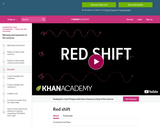
Edwin Hubble examined the spectra of many galaxies, looking for the red (longer wavelengths) or blue (shorter wavelengths) shifts in the spectra, indicating relative motion. To his surprise, not only did all of the galaxies appear to be moving, but all were moving away from us, no matter the direction of the galaxy. In addition, he found most galaxies exhibited a redshift, and the redshift was larger the further it was from our galaxy.Distant Nature: Astronomy Exercises 2016 by Stephen Tuttle under license "Creative Commons Attribution Non-Commercial Share Alike".
- Subject:
- Astronomy
- Material Type:
- Activity/Lab
- Author:
- Hollyanna White
- Date Added:
- 03/04/2022


